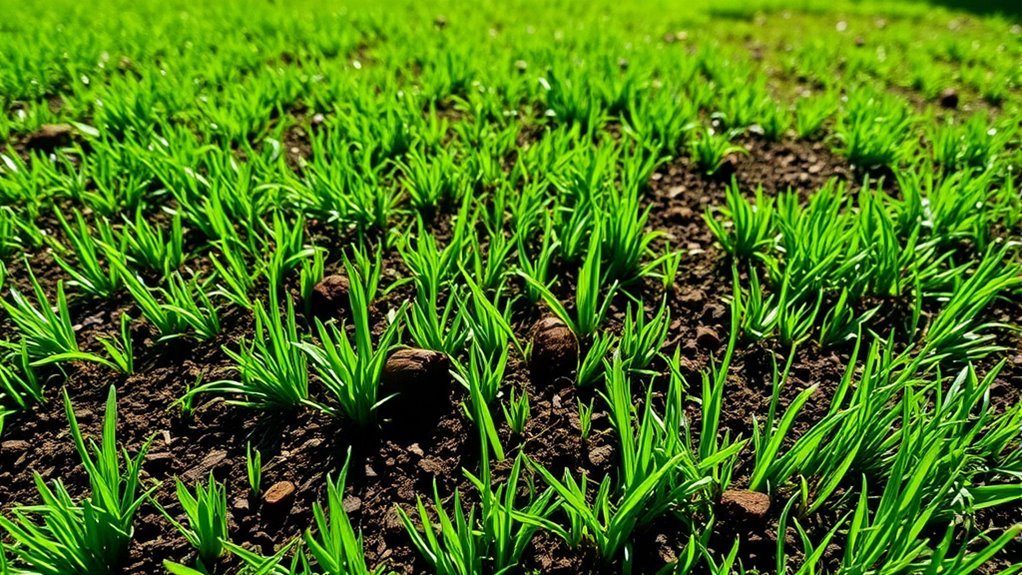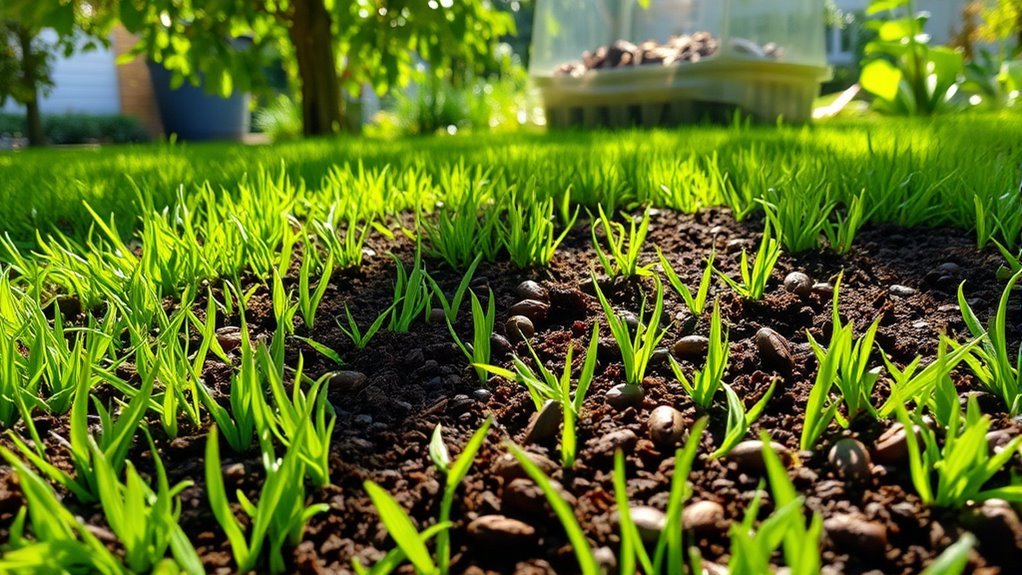Can I Sprinkle Coffee Grounds on My Lawn
Yes, you can sprinkle coffee grounds on your lawn. They provide essential nutrients like nitrogen, potassium, and phosphorus that promote healthy grass growth. Additionally, coffee grounds can improve soil structure, enhance moisture retention, and attract beneficial organisms like earthworms. However, be cautious with the amount you apply, as excessive use can lead to increased soil acidity. For best results, follow recommended application methods to maximize benefits, and you’ll discover even more about optimizing your lawn.
The Nutritional Benefits of Coffee Grounds for Grass

When you consider enhancing your lawn’s health, coffee grounds can be a surprisingly effective option. These grounds are rich in nitrogen, potassium, and phosphorus, essential nutrients that support grass growth. By incorporating coffee grounds into your lawn care routine, you can improve nutrient absorption in the soil. The fine texture of the grounds helps retain moisture and encourages beneficial microbial activity, further enhancing nutrient availability. As a result, your grass can thrive, exhibiting vibrant color and resilience against pests. Additionally, coffee grounds can help improve soil structure, creating a healthier environment for root development. Embracing coffee ground benefits not only supports your lawn’s health but also promotes sustainable practices by recycling food waste.
How Coffee Grounds Affect Soil Ph
When you add coffee grounds to your lawn, you’re influencing the soil’s pH levels. This can directly impact nutrient availability for your grass, as different pH levels can either enhance or hinder nutrient absorption. Understanding this relationship is vital for maintaining a healthy, vibrant lawn.
Soil Ph Levels
Although many gardeners appreciate the benefits of using coffee grounds, understanding their impact on soil pH is vital for maintaining healthy lawns. Coffee grounds can influence soil acidity, but the effect varies based on several factors. Here are three key points to take into account regarding pH measurement:
- Initial pH: Fresh coffee grounds are slightly acidic, usually around 6.0, but once decomposed, they can neutralize soil acidity.
- Soil Type: The existing soil pH plays a significant role; if your soil is already acidic, coffee grounds may exacerbate that.
- Application Rate: Over-application can lead to higher acidity levels, so moderation is key.
Nutrient Availability Impact
While coffee grounds can enhance soil structure, their impact on nutrient availability is significant for lawn health. When you add coffee grounds to your lawn, they promote nutrient cycling by providing essential nutrients like nitrogen, phosphorus, and potassium. This process supports microbial activity, which plays a fundamental role in breaking down organic matter and releasing nutrients into the soil. As microbial populations increase, they improve soil aeration and water retention, further benefiting your lawn. However, be mindful of the acidity; while coffee grounds can slightly lower pH, their overall effect is balanced when mixed with other organic materials. By understanding these dynamics, you can use coffee grounds effectively to bolster your lawn’s nutrient profile and liveliness.
Attracting Earthworms and Beneficial Microorganisms

To enhance your lawn’s health, attracting earthworms and beneficial microorganisms is essential, as they play a crucial role in soil aeration and nutrient cycling. Coffee grounds can help boost earthworm attraction and microorganism activity, benefiting your lawn in several ways:
- Organic Matter: Coffee grounds serve as a rich source of organic material, improving soil structure and promoting a diverse ecosystem.
- Moisture Retention: They help retain moisture in the soil, creating a favorable environment for earthworms and microorganisms.
- pH Balance: Although slightly acidic, coffee grounds can neutralize soil pH over time, enhancing microbial activity.
Incorporating coffee grounds into your lawn care routine can foster a thriving habitat for these crucial soil organisms, helping your grass flourish naturally.
Using Coffee Grounds as a Natural Fertilizer
Using coffee grounds as a natural fertilizer can enhance your lawn’s nutrient content considerably. They provide essential elements like nitrogen, phosphorus, and potassium, which promote healthy growth. To maximize their benefits, you’ll want to apply them correctly and understand the best techniques for spreading them across your lawn.
Nutrient Content Benefits
Since coffee grounds are rich in essential nutrients, they can be an excellent natural fertilizer for your lawn. When you use coffee grounds as organic amendments, you’re providing your grass with valuable coffee nutrients that promote healthy growth. Here are three key benefits:
- Nitrogen Boost: Coffee grounds contain about 2% nitrogen, which is vital for leaf development and overall plant health.
- Improved Soil Structure: They enhance soil aeration and drainage, leading to better root penetration and moisture retention.
- Microbial Activity: The grounds encourage beneficial microorganisms, which help break down organic matter, enriching the soil over time.
Application Tips and Techniques
When applying coffee grounds to your lawn, consider a few effective techniques to maximize their benefits. First, choose the right application methods; you can spread them directly or mix them into your compost. If you opt for direct application, aim for a thin layer—about ¼ inch—to prevent clumping. Regarding application frequency, apply coffee grounds every 4 to 6 weeks during the growing season for best results. Remember to water your lawn after application to help the nutrients penetrate the soil. Additionally, combine coffee grounds with other organic materials to create a balanced fertilizer. By following these tips, you’ll guarantee your lawn receives the full benefits of coffee grounds while maintaining healthy soil structure and fertility.
Potential Drawbacks of Sprinkling Coffee Grounds

Although coffee grounds can provide several benefits to your lawn, it’s essential to evaluate the potential drawbacks before incorporating them into your soil. Here are three key concerns:
- Coffee Ground Toxicity: While generally safe, large amounts may introduce harmful compounds that can affect plant growth.
- Excessive Acidity: Coffee grounds can lower soil pH, making it too acidic for certain plants, which could lead to nutrient deficiencies.
- Pest Attraction: The moisture in coffee grounds can attract pests like slugs and snails, potentially harming your lawn’s health.
Being aware of these drawbacks will help you make informed decisions about using coffee grounds effectively without compromising your lawn’s well-being.
Best Practices for Applying Coffee Grounds to Your Lawn
To guarantee your lawn reaps the benefits of coffee grounds, it’s essential to apply them correctly. Start by using ideal quantities—roughly 1 to 2 cups per 100 square feet of lawn. This amount guarantees your grass receives nutrients without overwhelming it.
As for application frequency, aim to spread coffee grounds about once a month during the growing season. This will help maintain optimal nitrogen levels in the soil. Before applying, consider mixing the grounds with other organic materials or soil to enhance their effectiveness.
Always monitor your lawn’s response and adjust quantities or frequency as needed. By being precise and mindful, you’ll create a vibrant, healthy lawn that thrives on the rich nutrients coffee grounds provide.
Coffee Grounds in Compost: A Perfect Match

Coffee grounds are a valuable addition to your compost pile, offering a rich source of nitrogen that helps balance the carbon-rich materials typically found in compost. Incorporating coffee grounds can enhance your composting techniques and maximize compost benefits. Here are three reasons to add them:
Adding coffee grounds to your compost boosts nitrogen levels and improves overall composting efficiency.
- Nutrient Boost: Coffee grounds provide essential nutrients, promoting microbial activity that accelerates decomposition.
- pH Balance: Contrary to popular belief, used coffee grounds are generally neutral, helping maintain a balanced pH level in your compost.
- Improved Aeration: The texture of coffee grounds can improve airflow in your compost pile, ensuring even decomposition.
Other Uses for Coffee Grounds in the Garden
While many people think of coffee grounds primarily as a composting material, they can also serve several other beneficial purposes in the garden. You can use coffee grounds as a compost accelerator, enhancing the breakdown of organic matter by adding nitrogen to your compost pile. This can lead to richer, more fertile soil. Additionally, coffee grounds can act as a pest deterrent. Sprinkling them around your plants may help repel common nuisances like ants, snails, and slugs. Their coarse texture can also improve soil aeration and drainage, promoting healthy root growth. By incorporating coffee grounds into your gardening routine, you’re not only recycling but also enhancing your garden’s overall health and productivity.
Final Thoughts on Coffee Grounds and Lawn Care

Incorporating coffee grounds into your lawn care routine can yield impressive results, much like their benefits in gardening. By utilizing this sustainable gardening practice, you can enhance your lawn’s health and promote organic lawncare. Here are three key benefits to reflect on:
- Nutrient Boost: Coffee grounds are rich in nitrogen, promoting lush, green growth.
- Soil Structure Improvement: They help aerate the soil, allowing better water retention and drainage.
- Pest Deterrent: Coffee grounds can deter certain pests, reducing the need for chemical treatments.
In short, adding coffee grounds to your lawn not only supports a healthier ecosystem but also aligns with your commitment to sustainable practices. Embrace this simple, effective method to elevate your lawn care routine.
Frequently Asked Questions
Can I Use Decaffeinated Coffee Grounds on My Lawn?
Yes, you can use decaffeinated coffee grounds on your lawn. While they may have slightly different nutrient levels compared to regular coffee grounds, the decaffeinated benefits still provide essential nutrients like nitrogen, phosphorus, and potassium. The nutrient comparison shows that both types can enrich your soil, promoting healthy grass growth. Just remember to apply them in moderation and mix them with other organic matter to guarantee balanced nutrient distribution and avoid any potential adverse effects.
How Often Should I Apply Coffee Grounds to My Grass?
Imagine your lawn as a canvas, waiting for the perfect strokes of nourishment. To maintain a healthy nutrient balance, you should apply coffee grounds every 4 to 6 weeks. This application frequency allows the grounds to break down and enrich the soil without overwhelming your grass. Just remember, moderation is key; too much can lead to imbalances. So, sprinkle wisely and watch your lawn thrive under the care of those aromatic grounds!
Do Coffee Grounds Attract Pests or Unwanted Animals?
Coffee grounds can attract certain pests, such as ants and snails, due to their appealing scent and nutrients. However, they might also act as an animal repellent; many critters dislike the strong aroma of coffee. If you’re considering using coffee grounds on your lawn, balance is key—apply them in moderation to reap the benefits without inviting unwanted visitors. Keep an eye out for any changes in pest activity in your yard.
Can I Mix Coffee Grounds With Other Fertilizers?
You can mix coffee grounds with other fertilizers, as they’re generally compatible. The coffee ground benefits include adding nitrogen, improving soil structure, and enhancing microbial activity. When combining them with other fertilizers, make certain that you balance the nutrient ratios to avoid overloading your plants. It’s also wise to test your soil first. This way, you can create an effective blend that promotes healthy growth without the risk of nutrient deficiencies or excesses.
Are There Any Specific Grass Types That Benefit More From Coffee Grounds?
You’d think every grass type would jump for joy at the sight of coffee grounds, but that’s not quite the case. Bermudagrass particularly thrives on that caffeine boost, showing remarkable resilience and color enhancement. Meanwhile, Fescue benefits from improved growth when mixed with coffee grounds, promoting a lush, green lawn. So, if you’re looking to elevate your grass game, focusing on these two varieties might just be your golden ticket to lawn success!






